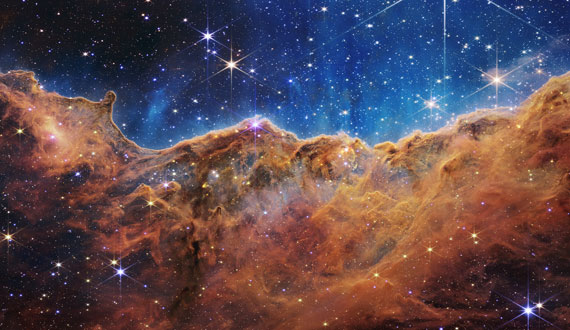Today NASA released groundbreaking photos from the James Webb Space Telescope, which is now in orbit around the sun, about a million miles from Earth.
Within the dust and gas in the Carina Nebula are hidden baby stars that are now uncovered by Webb. Just take a minute to look at the Carina Nebula—it’s amazing:
Access the incredible full resolution images here
What looks much like craggy mountains on a moonlit evening is actually the edge of a nearby, young, star-forming region NGC 3324 in the Carina Nebula. Captured in infrared light by the Near-Infrared Camera (NIRCam) on NASA’s James Webb Space Telescope, this image reveals previously obscured areas of star birth.
Called the Cosmic Cliffs, the region is actually the edge of a gigantic, gaseous cavity within NGC 3324, roughly 7,600 light-years away. The cavernous area has been carved from the nebula by the intense ultraviolet radiation and stellar winds from extremely massive, hot, young stars located in the center of the bubble, above the area shown in this image. The high-energy radiation from these stars is sculpting the nebula’s wall by slowly eroding it away.
NIRCam – with its crisp resolution and unparalleled sensitivity – unveils hundreds of previously hidden stars, and even numerous background galaxies. Several prominent features in this image are described below.
- The “steam” that appears to rise from the celestial “mountains” is actually hot, ionized gas and hot dust streaming away from the nebula due to intense, ultraviolet radiation.
- Dramatic pillars rise above the glowing wall of gas, resisting the blistering ultraviolet radiation from the young stars.
- Bubbles and cavities are being blown by the intense radiation and stellar winds of newborn stars.
- Protostellar jets and outflows, which appear in gold, shoot from dust-enshrouded, nascent stars.
- A “blow-out” erupts at the top-center of the ridge, spewing gas and dust into the interstellar medium.
- An unusual “arch” appears, looking like a bent-over cylinder.
This period of very early star formation is difficult to capture because, for an individual star, it lasts only about 50,000 to 100,000 years – but Webb’s extreme sensitivity and exquisite spatial resolution have chronicled this rare event.
Image credit: NASA, ESA, CSA, and STScI
Like This Article?
Don't Miss The Next One!
Join over 100,000 photographers of all experience levels who receive our free photography tips and articles to stay current:






